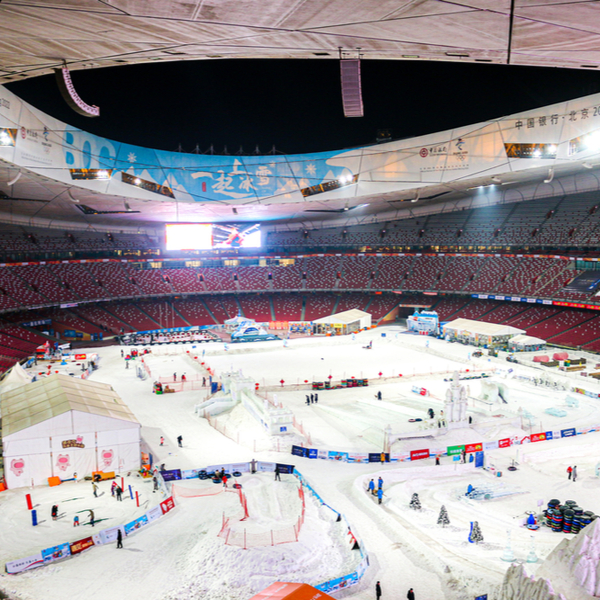The Beijing Winter Olympics showcased China’s stadiums, slopes and skating rinks. But when the competitors hang up their skis and snow boots, what happens to the impressive collection of facilities left behind? We’ve plunged into Beijing’s sports scene to find out what you can expect to see on a holiday to the city. Beijing’s Olympic Stadium is just the beginning. From snow parks and slalom runs to science museums and sightseeing towers, there’s much to explore – and possibly skate on, long after the Olympics are over.
Beijing Winter Olympics
In the winter of 2022, Beijing transformed into an Olympic city for athletes to compete in just 7 sports. Skiing, bobsledding, luge, biathlon, skiing, skating and curling will make up the 109 events where competitors faced slopes, rinks, tracks and half-pipes to compete for gold, silver and bronze medal positions.
Olympic sites
Beijing
Beijing’s stadiums have been upcycled from the Summer Olympics in 2008 to add a sustainable element to the 2022 Winter Olympics. The National Aquatics centre, also known as the Water Cube, was drained and repurposed to become the Ice Cube. Now a curling stadium, the ice has been built on a sturdy scaffold tower within the existing pool. The Fan (Beijing’s National Indoor Stadium) saw gymnasts tumble and twist their way to victory at the summer games. But in 2015 a full-sized ice rink was added to host the women’s world championship ice hockey matches. It’ll combine with the Wukesong Sports Centre to showcase the winter games’ ice hockey matches. For more high-speed action on the ice, spectators will head to the Capital Indoor Stadium for the drama-filled moments in the short track speed skating bouts and figure skating.

Making good use of a former steel works, the hugely anticipated Big Air Stadium saw freestyle snowboarders and skiers take to the skies with Beijing as the backdrop to their tricks, grabs and 1440°s. Which leaves just the National Speed Skating Oval. The only stadium to have been built from scratch, it still sits within Beijing’s Olympic Park.

Zhangjiakou
While Beijing’s stadiums have been recycled to create suitable venues, in Zhangjiakou new structures have been popping up across the Olympic site. The Guyangshu Cluster features three new areas for athletes to compete in biathlon, cross-country and ski-jumping. The only existing facilities are those at the Genting Snow Park – the area’s top ski resort.
Orbzii fact: 90% of the snow in Zhangjiakou was artificial. Though, Beijing’s snow-making equipment does run on 100% renewable energy.
Yanqing
In Yanqing, the focus is on the alpine and sliding events. This mountainous region of China is the ideal spot for the downhill, slalom and super-g, with the newly built sliding track providing a testing run for the bobsleigh, luge and skeleton competitors. The first sliding track in the world to ever feature a 360° turn, the ice will be tricky to navigate for even the most experienced sliders.


Olympic Park
If the Beijing Winter Olympics has inspired you to take a trip to the city, do swing by the Olympic Park. At nearly 3,000 acres of Beijing real estate it’ll require a sturdy pair of shoes and a fair bit of exploring to see it all. Split into three sections, the park contains some of the Olympic’s most iconic stadiums, but also some added experiences and activities to break up the stadium-selfie action. In the central section – near the Bird’s Nest and Water Cube, you’ll find China’s Science and Technology Museum. In the southern section, you’ll find the China Ethnic Museum which showcases buildings, temples and homes that depict the architectural styles of China’s multi-cultural population. And, in the northern section, you can shimmy up the Sightseeing Tower to take in the views over the park below – and beyond.
Orbzii tip: Though the science museum does have some English information panels, many of the displays are explained in Chinese only.
After the Olympics
After the Olympic and Paralympic Games ended, the sports stadiums continue to host competitions, events and provide space for athletes to train, the Olympic villages are due to be overhauled and revamped into new facilities for the city. In Beijing, the village will simply be repurposed into rentable apartments. So expect a few to appear on Airbnb as unique stays. Plans for the Zhangjiakou village are a little less exciting. The accommodation will be changed into a business park.


Perhaps more interesting for Beijing visitors are the venues you can visit – and experience to get a slice of Olympic action. The Genting Snow Park in Zhangjiakou will revert back to being one of China’s top ski resorts. And, though it might be a three hour drive from central Beijing, it’s just a one hour zip on the bullet train. While you’re in Zhangjiakou, you’ll also be able to drop into the National Cross-Country Centre – which is set to become a campsite and outdoor ice sports centre. The area’s ski jumping and biathlon centres will become training camps for China’s national teams – but also a tourist resort.
Keen to continue watching the luge, bobsled and skeleton long after the Olympics are over? Yanqing’s tracks at the National Sliding Centre will be hosting international events in the coming years. You might also be able to catch the world’s top skiers taking on the slopes of the National Alpine Ski Centre. The viewing areas and facilities created for the slalom, super-g and downhill events will be kept to provide a competition venue – and training space for China’s alpine team.




















